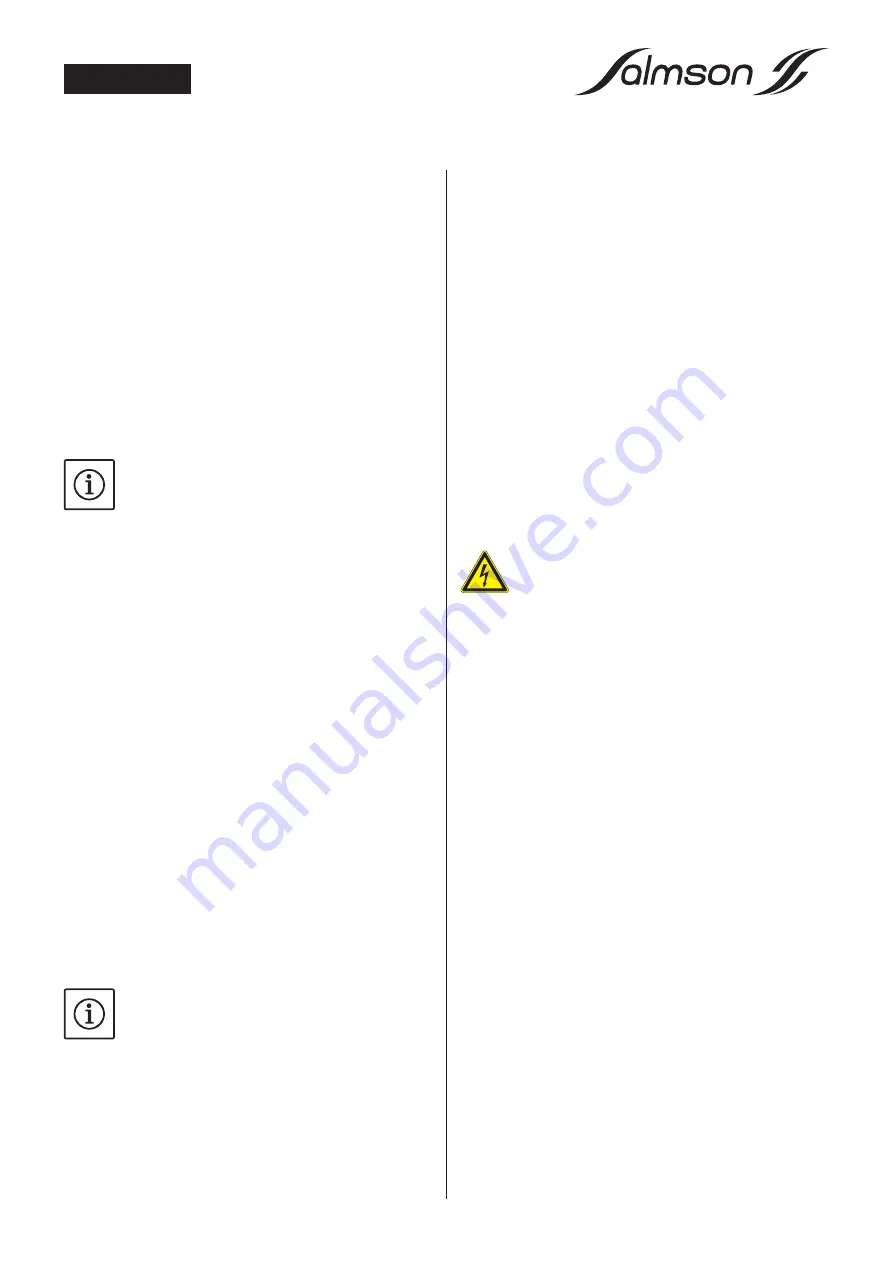
35
English
7.5.
Activating automatic mode on the unit
Before automatic mode is switched on, check the settings for the
switching level and follow-up time.
If all settings have been checked, you can switch the unit on.
1. Press the "auto" button on the control panel.
2. The "auto" LED lights up and the unit now runs in au-
tomatic mode. As soon as the float switches provide a
corresponding signal, the pump is activated
•
"Pump ON" level: If the activation level is reached, the
pump switches on and the "Pump operation" LED lights up
permanently.
•
"Pump OFF" level: If the off level is reached, the follow-up
time set is active. During the follow-up time, the "Pump
operation" LED flashes. Once the follow-up time has
expired, the pump switches off and the "Pump operation"
LED goes out.
NOTE
High-water protection is active in automatic mode.
When the activation level for high-water protection
is reached, the following occurs:
•
Forced switch-on of the pump.
•
A
visual warning, the "High water" LED, lights up
permanently.
•
An
audible warning is emitted via a constant signal.
•
The
collective fault signal contact (SSM) is activated.
7.6.
Conduct during operation
When operating the switchgear, always follow the locally applica-
ble laws and regulations for work safety, accident prevention and
handling electrical products.
To help to ensure safe working practice, the responsibilities of
employees should be clearly set out by the operator. All personnel
are responsible for ensuring that regulations are observed.
Check the settings at regular intervals as to whether they meet
the current requirements. The settings may need to be adjusted.
8.
Shutdown/disposal
All work must be carried out with the greatest care.
8.1.
Deactivating automatic mode on the unit
1. Press the "Stop" button on the control panel.
2. The "Pump operation" LED goes out.
3. The "auto" LED flashes
4.
The switchgear is in stand-by mode.
NOTE
High-water protection is
not
active in standby mode.
When the activation level for high-water protection
is reached, the following will occur:
•
no
forced switch-on of the pump
•
A
visual and audible warning
•
The
collective fault signal contact (SSM) is activated.
8.2.
Temporary shutdown
For temporary deactivation, the control is switched off and
switchgear is switched off via the main switch.
The switchgear and the unit are now ready for operation at any
time. The defined settings are stored retentively in the switchgear
and are not discarded.
Make sure that the ambient conditions are observed accordingly:
•
Ambient/operating temperature -30 ... +60 °C
•
Air humidity: 40...50 %
Prevent formation of condensate!
BEWArE
of moisture!
Ingress of moisture will result in damage to the
switchgear. During standstill time, pay attention to
the permissible air humidity and ensure the switch-
gear is stored so it is safe from overflowing.
1. Press the "Stop" button.
2. Wait until the "Pump operation" LED goes out.
3. The "auto" LED flashes.
4.
Switch off the switchgear using the main switch ("OFF"
position).
8.3.
Final shutdown
PoTEnTIALLy fatal danger due to electrical voltage
Incorrect procedures can cause fatal electric
shocks. This work may only be carried out by a
qualified electrician approved by the local pow
-
er supplier, in accordance with locally applicable
regulations.
1. Press the "Stop" button.
2. Wait until the "Pump operation" LED goes out.
3. The "auto" LED flashes.
4.
Switch off the switchgear using the main switch ("OFF"
position).
5. Switch off the entire unit so it is voltage-free and secure it
against accidental activation.
6. If the terminal for the collective fault signal is occupied,
the external voltage source present there must also be
switched so it is voltage-free.
7. Disconnect all power supply cables and pull these out of
the threaded cable connections.
8. Connect the ends of the power supply cables so that no
moisture can enter into the cable.
9. Dismount the switchgear by undoing the screws on the
substructure.
8.3.1. return delivery / storage
For shipping purposes, the switchgear must be packaged so it is
protected against knocks and waterproof.
Please also refer to the “Transport and storage”
section.
8.4.
Disposal
Proper disposal of this product avoids damage to the environment
and risks to personal health.
•
Use the services of public or private waste disposal com-
panies, or consult them for the disposal of the product or
parts thereof.
•
More information about proper disposal can be obtained
from the municipal authorities, the waste disposal authori-
















































